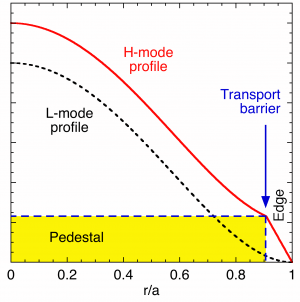Pedestal: Difference between revisions
No edit summary |
No edit summary |
||
| Line 1: | Line 1: | ||
[[File:H-mode.png|300px|thumb|right|Sketch of L- and H-mode profiles and pedestal.]] | [[File:H-mode.png|300px|thumb|right|Sketch of L- and H-mode profiles and pedestal.]] | ||
In the context of magnetic confinement fusion, the term ''pedestal'' refers to a relatively narrow edge plasma region with significantly enhanced | In the context of magnetic confinement fusion, the term ''pedestal'' refers to a global increase of a profile (such as the pressure), caused by the formation of a relatively narrow edge plasma region with significantly enhanced profile gradients, associated with an edge transport barrier, characteristic of the [[H-mode]]. | ||
<ref>[http://dx.doi.org/10.1088/0029-5515/29/11/010 ASDEX Team, ''The H-Mode of ASDEX'', Nucl. Fusion '''29''' (1989) 1959]</ref> | <ref>[http://dx.doi.org/10.1088/0029-5515/29/11/010 ASDEX Team, ''The H-Mode of ASDEX'', Nucl. Fusion '''29''' (1989) 1959]</ref> | ||
When transiting from the L-mode to the H-mode, the appearance of the pedestal often leaves the profile gradients in the core region intact (due to [[Profile consistency|profile consistency]]) whereas the edge gradients increase sharply. Thus, it appears as if the core profiles are merely shifted upward (as if put upon a pedestal), hence the terminology. | When transiting from the L-mode to the H-mode, the appearance of the pedestal often leaves the profile gradients in the core region intact (due to [[Profile consistency|profile consistency]]) whereas the edge gradients increase sharply. Thus, it appears as if the core profiles are merely shifted upward (as if put upon a pedestal), hence the terminology. | ||
Physically, the edge region is complex as it contains the transition ([[Separatrix|separatrix]]) from the confined plasma with closed field lines to the scrape-off layer (SOL) with open field lines; transport fluxes are large there; and the interaction with the wall (atomic and molecular physics) is important. | Physically, the edge region is complex as it contains the transition ([[Separatrix|separatrix]]) from the confined plasma with closed field lines to the scrape-off layer (SOL) with open field lines; transport fluxes are large there; and the interaction with the wall (atomic and molecular physics) is important. | ||
The understanding of this region is still imperfect. | The understanding of this region, and therefore of the pedestal, is still imperfect. | ||
Many attempts have been made to derive [[Scaling law|scaling laws]] of phenomenological pedestal parameters (such as its width and height), with limited success. | Many attempts have been made to derive [[Scaling law|scaling laws]] of phenomenological pedestal parameters (such as its width and height), with limited success. | ||
<ref>[http://dx.doi.org/10.1088/0741-3335/42/5A/302 A.E. Hubbard, ''Physics and scaling of the H-mode pedestal'', Plasma Phys. Control. Fusion '''42''' (2000) A15]</ref> | <ref>[http://dx.doi.org/10.1088/0741-3335/42/5A/302 A.E. Hubbard, ''Physics and scaling of the H-mode pedestal'', Plasma Phys. Control. Fusion '''42''' (2000) A15]</ref> | ||
Revision as of 14:40, 9 July 2011

In the context of magnetic confinement fusion, the term pedestal refers to a global increase of a profile (such as the pressure), caused by the formation of a relatively narrow edge plasma region with significantly enhanced profile gradients, associated with an edge transport barrier, characteristic of the H-mode. [1] When transiting from the L-mode to the H-mode, the appearance of the pedestal often leaves the profile gradients in the core region intact (due to profile consistency) whereas the edge gradients increase sharply. Thus, it appears as if the core profiles are merely shifted upward (as if put upon a pedestal), hence the terminology.
Physically, the edge region is complex as it contains the transition (separatrix) from the confined plasma with closed field lines to the scrape-off layer (SOL) with open field lines; transport fluxes are large there; and the interaction with the wall (atomic and molecular physics) is important. The understanding of this region, and therefore of the pedestal, is still imperfect. Many attempts have been made to derive scaling laws of phenomenological pedestal parameters (such as its width and height), with limited success. [2] [3]